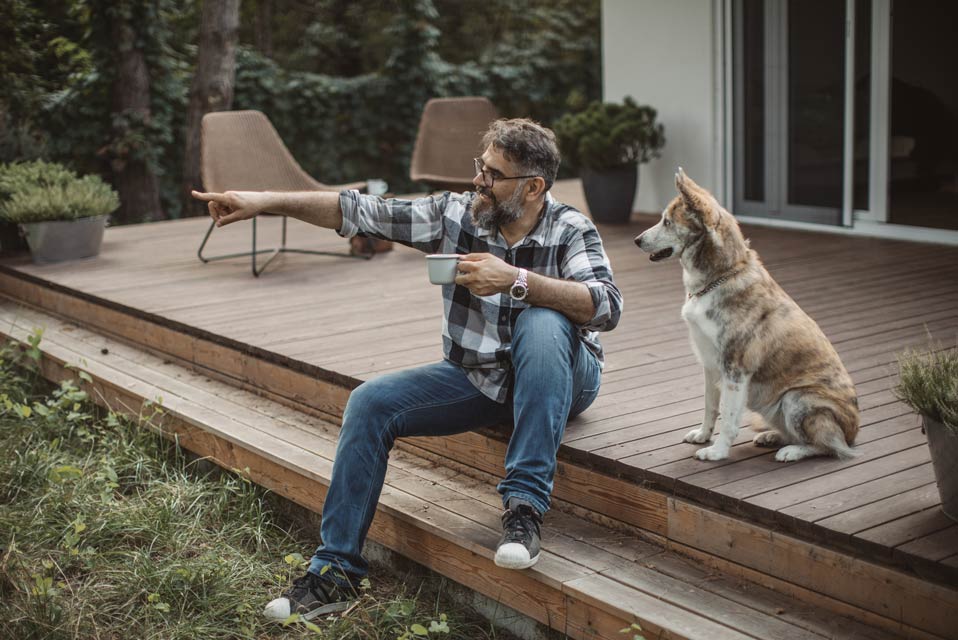How to Teach Your Dog the Look Command

The look command means that your dog should follow your finger and place attention where you are pointing. While it may seem like a command that is limited in its practical use, it is beneficial for your dog to know.
If your dog is prone to getting distracted while you're out on a walk, lunging at things, pulling on the leash, and generally not being able to rein in her curiosity and focus, the look command can help.
The reason the look command helps in those situations is that it teaches your dog to cast her attention where you direct her but then return it to you. So, even though you may be pointing out something interesting or exciting by using the look command, your dog will learn to check it out but then look at you to find out what's next. That can help keep her from getting too excited and pulling on the leash to get to the exciting thing. (You can learn other techniques for leash-pulling here: "How to Train Your Dog to Walk Nicely on a Leash.")
How to Teach the Look Command
Here is a step-by-step guide for teaching your dog the look command.
Note: Dog training can go more smoothly if you choose a treat your dog really likes, do training sessions after a play session releases excessive energy, and train when your dog has a slightly empty stomach and will work even harder for the treats. Additionally, you should always approach dog training with positive reinforcement in mind. Reward for good behavior and, as much as possible, ignore the behavior you don't like. Clicker training can be extremely helpful. Learn more: "Clicker Training for Dogs: An Overview."
- First, get a toy that you know your dog really loves. It helps if it's one that makes a noise.
- Tell your dog to sit and stay, and put the toy behind your back.
- Get your dog's attention.
- Once her eyes are on yours, move the toy out, away from your body, and say, "Look."
- When you see a movement of your dog's eyes toward the toy, say "yes" or click your clicker and then give a treat as a reward by continuing to hold the toy out but directing your dog's attention away from it and back to you.
- Over time, begin to save the treat longer and longer before giving the reward.
- Once your dog will reliable look at the toy, save the reward for when she returns her attention to you after looking at it. Initially, you will need to do something to get her to look back at you, but eventually, she will do it automatically.
- Once your dog looks back at you reliably after looking at the toy, begin practicing the look command with a pointed finger at something else in the area. Start with an object that's close to you and move it away gradually as she gets it.
- Once your dog reliably looks at what you're pointing at and then calmly back at you, add distractions to your training. You can do that by having a friend help and make noise nearby or by going for an actual walk. Just remember to take the treats with you.
- Remember that you'll need to continue practicing with your dog to make sure she remembers the look command. Even doing training sessions consistently once a week as refreshers is a good idea.
Training your dog to follow commands is a great way to bond with her. It also reduces stress and helps keep her mind sharp as well as helping the two of you have a better relationship because she understands what you want.
You May Also Like These Articles:
3 Commands That Could Save Your Dog's Life
Clicker Training for Dogs: An Overview
Disclaimer: This website is not intended to replace professional consultation, diagnosis, or treatment by a licensed veterinarian. If you require any veterinary related advice, contact your veterinarian promptly. Information at DogHealth.com is exclusively of a general reference nature. Do not disregard veterinary advice or delay treatment as a result of accessing information at this site. Just Answer is an external service not affiliated with DogHealth.com.
Notice: Ask-a-Vet is an affiliated service for those who wish to speak with a veterinary professional about their pet's specific condition. Initially, a bot will ask questions to determine the general nature of your concern. Then, you will be transferred to a human. There is a charge for the service if you choose to connect to a veterinarian. Ask-a-Vet is not manned by the staff or owners of DogHealth.com, and the advice given should not delay or replace a visit to your veterinarian.



